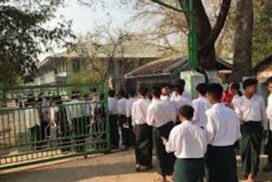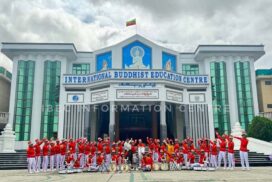By Dr Myint Zan
The 11th of March 2024 (to use the historic present tense) is a notable date in the educational history of Myanmar. Since perhaps the 1920s (if not earlier), government-sponsored Matriculation exams have been held (with a few exceptions) almost yearly in the months of March or April. Matriculation students had to study until the 10th standard, and at the end of the tenth standard, they had to sit for the government-supervised Matriculation exams. Now, for the first time, those who take the Matriculation exam starting in 2024 are Grade XII (12th standard’) students. Students would have to spend roughly 12 years in high school (instead of the usual 10) before they are eligible to take the matriculation exams.
Myanmar sar and English are the compulsory ‘language papers’ regardless of the arts, science or arts-science combination that students take for the Matriculation exams.
This article provides a survey of the prescribed textbooks in the compulsory English papers used for the school (academic) years 1968-69 to 2018-19.
Matriculation English Texts from 1968-69 to 1972-73: Six Tales from Shakespeare and Seven Inventors
Six Tales from Shakespeare are retold ‘tales’ in simple English mainly targeted at 8/9 to 11/12 years old native speakers. The copy that I have was printed in 1971 by Trade Corporation 9, Rangoon. The slim booklet covers Shakespeare’s plays The Merchant of Venice, Taming of the Shrew, The Tempest, Julius Caesar, King Lear and Macbeth. It was taught in both the 9th and 10th standards during those years.
The text Seven Inventors, mainly taught in the then 10th standard, is less easy to comprehend than the simplified Six Tales from Shakespeare. The author was Harry McNicol. A quick search on the World Wide Web yields the information that it was first published by Oxford University Press in 1943. It narrates the life stories and inventions of Richard Arkwright, Josiah Wedgwood, Charles Goodyear, The Brothers Wright, Thomas Edison and Guglielmo Marconi.
There have been a few critiques of the two prescribed textbooks, and in a Letter to the Editor of the Guardian (Rangoon) published on or around 20 October 1972, E W Dalton, who has written English grammar texts, stated that, among others, the weak standards of most high school students in Myanmar may, in part, be due to the two textbooks. (Mr Dalton also listed other reasons.)
Similar concerns about the generally low standard of English were echoed by the late Saya Tet Toe, whose article in The Working People’s Daily on or about 21 June 1973 was titled ‘English: A Killer’. From my firm memory, Tet Toe started his article thus: ‘If a student fails the (Matric) exam he or she rarely fails to fail in English’ and he concluded: ‘Something should be done to change this killer subject into a stimulus for improvement’.
Perhaps in part to ‘stimulate’ improvement, the Matriculation textbook starting from the academic year 1973-74 (the very year Tet Toe’s article appeared) was changed.
Matriculation English Texts for the year 1973-74 to 1985-86
This text, which lasted 13 academic years, is not based on a particular book like Seven Inventors, but it is a compilation of various articles in a single book. Yours truly cannot find or purchase the book, so you cannot reproduce the photo of the book here. The writer’s recollection contains a chapter in simple English about the Burmese military commander Maha Bandoola (6 November 1782-1 April 1825) and primatologist Jane Goodall (born 3 April 1934).
The format of the Matriculation English exams changed too. When the two texts above were taught from 1968-69 to 1972-73, the exam questions included an (unseen) Essay question. In fact, three topics were given in the 1970 English exam paper ‘Write three paragraphs of one of the following: Your Town, Your Teacher, Your Ambition’. I was told by a teacher who had marked English Matric papers that a few students, when writing their essays, just copied and pasted the essay question ‘Your Town’ instead of writing ‘My Town’!
Moreover, when answering the question on the retold story ‘Macbeth’, a student wrote ‘Macbeth and Banquo came back from the bottle and are on the heat’ when she or he actually meant ‘Macbeth and Banquo came back from the battle and were riding across the heath (when they met the three witches)’. Another report which I recall reading from the then English Department on the exams was that there was a question worth ten marks with ten fill-in-the-blanks and ten sentences. Students have to choose to fill in the blanks from the words provided. I definitely recall reading in the report that a student wrote, ‘He drives his car very slowly because the road is vegetables’! (instead of ‘dangerous’) Both ‘vegetables’ (for the sentence ‘U Ba grows vegetables in his garden’) and ‘dangerous’ were in the list above the blanks.
There were no prompts or outlines for the essay provided at the start of the essay in the essay questions for the years 1968-69 to 1972-73.
In contrast, I clearly recall the 1974 English Matric exam with the new textbook had the essay (no choices were given) ‘Why I like dogs better than cats’ (or vice versa) with prompts. In 1986 (the last year this textbook was used before the text shifted to a truncated, simplified version of Wuthering Heights with prompts was ‘My favourite Aunt’. I have learned that a few students wrote in their papers, ‘There are two kinds of ants: the black ants and the red ants’!
Moreover, there were two parts in the Matric English paper during those 13 years. Part A consists of multiple choice questions, which are worth around 30 marks or even 40 marks out of 100 marks.
Not only did the textbook change starting from the academic year 1986-87 for Matriculation students but the so-called Part A of multiple choice questions was also gone. Perhaps since 1987, no prompts or outlines have been given in the compulsory essay questions in the Matriculation English papers.
Simplified version of Wuthering Heights 1986-87 to (1992-93?)
Emily Bronte (30 July 1818-19 December 1848) first published her novel Wuthering Heights (initially under the pseudonym Ellis Bell) in 1847. One hundred and forty years later (to repeat), a simplified version of the only novel that she published became a text for about seven years for Matriculation students in Burma.
A former Professor of Myanmar language who had temporarily taught Myanmar Sar in a neighbouring country has stated how she, as a 16-year-old, had to struggle with the love story of the hero-villain Heathcliff and Cathy Earnshaw.
I do not know the exact year the truncated Wuthering Heights ceased to be a Matriculation English text, but it may have ended with the 1993 Matriculation exam or a year earlier or later. When the text was introduced in the 1986-87 academic year, the then Education Minister declared his ‘avowed’ aim of enhancing the standard of education. Thus, the then education authorities made Wuthering Heights (simplified version), which was taught in the intermediate classes at Rangoon University in the early 1960s, should be taught in the Matriculation year in the whole nation. Or so I have heard.
Those years saw the re-division of arts and science subjects, starting in the ninth standard. The anomaly of the Wuthering Heights as Matric-English-text-years was such that those who passed the Matriculation exam from the again redivided Science combination even if they got distinctions (75 per cent and above) in English could not take ‘arts subjects’ like English (for that matter Myanmar, Law, Philosophy etc) but perhaps those who got say 55 per cent or even 50 per cent in the Matriculation English marks from the Arts Division can take English as a major! After about five to seven years of Wuthering Heights (simplified version) the Matric English text was changed again.
Thirty Burmese (Myanmar) Tales as Matric Text from 1993-94 (?) to 1999-2000(?)
Thirty Burmese Tales (later Thirty Myanmar Tales) was first published by Oxford University Press in 1952. It was authored by our very own Sayagyi Dr Htin Aung (18 May 1909-10 May 1978), who, among many others, was Vice-Chancellor of the University of Rangoon.
Dr Htin Aung’s book was also one of the Matric texts in the year 1953-54 and perhaps later and earlier years. It became the Matric English text again starting from 1993-94 (or a year or two earlier) and ended in 1999-2000 or a year or two earlier. I had the chance to re-read the book just several days ago, and I learned the origin of the use of the Myanmar terms (Po Nay Myae Kyar Nay Myae ပိုနေမြဲကျားနေမြဲ) (Maung Po remains in the same/previous place and the tiger remains in the same/previous place’) the story of (Shin Mway Noone ရှင်မွေးနွမ်း) and the root of the term (Akyan Koan Galon Sar Chet အကြံကုန် ဂဠုန်ဆားချက် (‘The Galon bird/Garuda running out of options began to process salt by the sea shore’). Thirty Myanmar Tales as a Matric text lasted about five or six years. Its ‘tenure’ is roughly the same as those of Six Tales from Shakespeare and Seven Inventors, which lasted five years from 1969 to 1973.
Matric Text with the longest ‘tenure’ from 1999-2000 to 2018-19
Almost a generation of matriculated students have had to study the same or very similar Matric text post-1999. From the academic year 2020-21, Grade XI and Grade XII additional English texts were produced. Hence, there may be innovations and amendments to the previous text for the 10th standard. The changes and/or additions of texts, say, from Wuthering Heights (edited and simplified) to Thirty Myanmar Tales were radical changes, but post-2020 changes (in the form of additional texts,) unlike previous changes, display continuity in substance and pedagogy.
The concerned educational authorities are to be complimented for not changing the texts for quite some time (around 20 years) and for specifically including techniques to enhance reading, writing, vocabulary, and even speaking skills among the students fairly comprehensively in the current English textbooks for Grades X, XI and XII.
Moreover, for the past 20 years or so, the exam questions can be said to be of higher quality, especially those dealing with essays. Compare the compulsory single essay question (in that there is no choice) with outlines or ‘prompts’ provided: ‘Why I like dogs better than cats’ in the 1974 Matric exam with the 2018 essay question without prompts ‘Trees are the lungs of the Earth’. Compare also the single essay question in the 1986 Matric exam, ‘My favourite Aunt’ (with prompts), with one of the three essay questions in the English exam held on 12 March 2024: ‘Benefits and drawbacks of making new friends online’ (without prompts). (In the year 1986, even more so in 1974, none of the students and, for that matter, English teachers would understand the current implications of the word ‘online’ since the internet and the world wide web were a long way off in the future!)
Suggestions for research
I have focussed mainly on past textbooks and have written relatively little on current high school and matriculation texts as they are easily available.
It is advisable indeed it would be beneficial to do further research for, say, an honours paper or even an MA thesis for English major students and education-related scholars to pedagogically study the five series of Matric English texts of the timeline provided (50 years: 1969 to 2019).
A pedagogic study of these texts could include but would not be limited to the reasons or motives for adopting these prescribed texts in the respective years; the teachers’ guides (if any: some of the texts have had separate teachers’ guides); the methodology of teaching and learning these texts: the pass and failure rates in the English language papers when these texts were prescribed (it is realized that these may be difficult to retrieve); the reports of the respective English Departments after the exam results (I have seen and read at least one of those reports); interviews with English language teachers who had taught as well as students who had gone through these texts (again it is realized that it would be easier to retrieve information about texts post-1990s and post-2000 than in the earlier years).
Conducting such research and writing an academic paper or thesis may be a challenging task, but it is a worthwhile undertaking. This narrative, survey and comments are written mainly with the aim of encouraging English and ‘education major’ students and researchers to embark on such a study.













